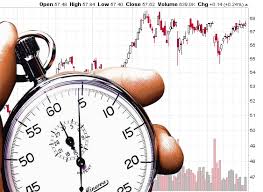WHY MARKET TIMING IS NOT ALWAYS A BAD IDEA
If you had a chance to read 4-parts post about my way to invest, you have already figured out that I am a contrarian investor. It simply means that I don’t listen to talking heads who preach the same strategies that don’t work in most cases. I am always looking for a nontraditional approach to investing. So far, it has served me well.
Let’s talk about market timing. I bet you have been reading in multiple articles on the Internet that the market timing doesn’t pay off because you never know what will happen with the market tomorrow or in the future. There are even some very convincing tables and graphs in every article.
To some degree, it is a viable argument. Nobody can predict the future, especially in the long run.
While it is unrealistic to assume that you will buy at the very bottom and sell at the very top, there are ways to spot the market changes in trends as they emerge. What if I tell you that there is a way to play the market and be successful with market timing? What if some simple rules will allow you to use a certain strategy and be successful with it?
Intrigued? Let’s discuss.
Long-term success in the stock market starts with many components as I have reflected in the previous post. Earlier or later, you will have to choose the strategy that will keep the odds in your favor and will manage potential risk. The strategy should reflect not only the cyclical nature of the stock market but also when to buy or sell. With today’s market volatility, it is critically important.
The key to the market timing strategy is using the right tool. My right tool is not a big secret. This tool existed for many years and it’s called the IBD.
The IBD identifies 3 market conditions, and, depending on condition, you will have a clear signal on what to do with your assets. The Market Pulse section of IBD helps you spot major changes in trend by identifying which of the three possible stages the market is in every trading day.
The stages are:
- Market in a confirmed uptrend
- Market under pressure
- Market in correction
So, what those stages are telling you?
- Market in a confirmed uptrend: invest 100% of cash – the best time to buy;
- Market under pressure: keep invested only 50% of your assets – there was heavy selling for a few days – it’s time to reduce your market exposure because it may turn to downtrend;
- Market in correction: go to 100% cash and avoid making new investments and cut short any losses.
Simple? You bet. The beauty of this approach is that over time, this strategy has bitten S&P 500 handsomely.
If you are a novice investor and got lost in various strategies, this one will give you quite a simple roadmap to successful trading. The only expense you need is to get the IBD (Investors Business Daily) subscription at investors.com.
Even if you are an experienced investor, the IBD subscription will pay you off. I am an IBD subscriber for more than 10 years. I am getting the newspaper every Friday evening and have time to review multiple sections. At the same time, you can access the IBD online and use generous tools that score the stocks with multiple parameters, valuations; see the charts, the list of the best stocks, ETFs, etc., as well as many educational articles for traders. You won’t regret it.
Guys, I don’t want to look like the paid advertiser (I have nothing to do with this company). I simply want to recommend this “tool” for your benefit.
Of course, you still have to use your set of rules for buying/selling on profit-taking or cutting losses. Buy the way, you can start developing the rules just by using the IBD’s approach to finding the best stocks. Especially it is useful for those investors who have chosen the swing (or momentum) trading.
IBD offers the Stock Checkup online that immediately reflects the total score for any particular stock (except stocks that are traded on the OTC market). This is an amazing tool for all types of investors as well as the Industry Group Rank that identifies which industry is moving up or down in the table of 197 industries.
The IBD’s CANSLIM investing system identifies seven common characteristics for winning stocks (like exceptional earnings and sales growth, innovative product, or strong demand from mutual funds). Use them for your trading rules. Use the Sector Leaders section. Use the IBD 50 list or just trade the FFTY - Innovator IBD 50 ETF.
My charting skills have significantly improved since I have been using IBD tutorials. Here is what the IBD founder W. O'Neil said: “ fortunes are made every year by the people who learn to properly read charts”.
As soon as you start reading the IBD newspaper, your investment horizon will expand and your trading skills will become more precise and more successful.
Believe it or not, W. O’Neil’s investing system was the heist rated among 18 others (source: S. Rogers).
Because you have been a patient reader, I am attaching the IBD’S Stock Checkup List as bonus #1. Enter the data about your chosen stock in the empty fields.
Look also for bonus #2: IBD’s 20 Trading Rules. You can include them in your set of trading rules.
Buying Checklist
Use this checklist to see if your stock has the CAN SLIM traits the best stocks typically display as they climb higher. While few stocks will meet every benchmark, focus on the top-performing names.
CURRENT MARKET OUTLOOK (See Market Pulse inside The Big Picture)
- Market In Confirmed Uptrend __
- Uptrend Under Pressure __
- Market In Correction __
Tip: Best to buy in a confirmed uptrend. Avoid new buys when the market is in a correction and proceed with caution when the uptrend is under pressure.
Company Name: _____________________________ Ticker: ___________
Date: _______________
COMPANY FUNDAMENTALS & INSTITUTIONAL DEMAND (See IBD Stock Checkup)
Metric / Your Stock / Target Benchmark
- Composite Rating _________ 95 or higher
- EPS Rating _________ 90 or higher
- EPS % Change Last Quarter _________ 25% or higher
- Last 3 Quarters Average EPS Growth _________ 35% or higher
- Quarters of EPS Acceleration _________ 1 or more
- Sales Growth Last Quarter _________ 20% or higher
- Return on Equity (ROE) _________ 17% or higher
- SMR Rating (sales, margins, ROE) _________ A or B
- New Product/Service or Management _________ Yes
- Among Top-Rated Stocks in Group _________ Yes
- Industry Group Rank _________ Top 40 among 197
- Quarters of Increasing Fund Ownership _________ 1 or more
- Accumulation/Distribution Rating _________ A, B or C
- Relative Strength Rating _________ 75 or higher
- Current Share Price _________ $15 or higher
- Average Daily Volume _________ 400,000 or more shares
CHART ANALYSIS (See IBD Charts)
Tip: Buy stocks as they break out of sound chart patterns in unusually heavy volume.
- Type of Base Forming: ______________________________________
- Buy Point: __________
- Volume % Spike on Day of Breakout: ________% (Look for 40% or higher)
- Relative Strength Line at Or Near New High at Breakout: Yes / No
- Consider buying stocks with each of the last three years’ earnings up 25% or more, return on equity of 17%+, and recent earnings and sales accelerating.
- Recent quarterly earnings and sales should be up 25% or more.
- Avoid cheap stocks. Buy higher-quality stocks selling $15 a share and higher.
- Learn how to use charts to spot sound buy points. Confine your buys to these points as stocks breakout on big volume increases.
- Cut every loss when it’s 8% below your cost. Make no exceptions so you can always avoid huge, damaging losses. Never average down in price.
- Have selling rules on when to sell and take a profit on the way up. Review "When to Sell and Take a Profit" in “How to Make Money in Stocks”.
- Buy when market indexes are in an uptrend. Reduce investments and raise cash when general market indexes show five or more days of volume distribution.
- Read IBD’s "Investor’s Corner" and "The Big Picture" columns to learn how to recognize important tops and bottoms in the market indexes.
- Buy stocks with a Relative Price Strength Rating of 85 or higher in the IBD SmartSelect® Corporate Ratings.
- Pick companies with management ownership of stock.
- Buy mostly in the top six broad industry sectors in IBD’s New High List.
- Select stocks with increasing institutional sponsorship in recent quarters.
- Current quarterly after-tax profit margins should be improving and near their peak margins.
- Don’t buy because of dividends or P-E ratios. Buy the #1 company in an industry in earnings and sales growth, R.O.E., profit margins, and product quality.
- Pick companies with a new product or service.
- Invest mainly in entrepreneurial New America companies. Pay close attention to those with an IPO in the past 8 years.
- Check into companies buying back 5% to 10% of their stock and those with new management (what is management’s background?).
- Don’t try to bottom guess or buy on the way down. Never argue with the market. Forget your pride and ego.
- Find out if the market is currently favoring big cap or small-cap stocks.
- Do a post-analysis of all your buys and sells. Post on charts where you bought and sold each stock. Evaluate and develop rules to correct your major past mistakes.
Like this article? Found it useful? Subscribe for free to get notifications about new posting.


